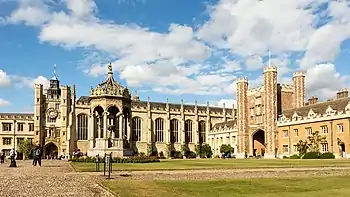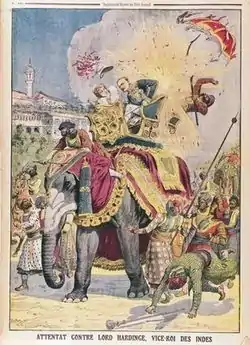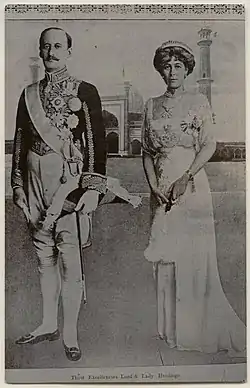Charles Hardinge, 1st Baron Hardinge of Penshurst
Charles Hardinge, 1st Baron Hardinge of Penshurst, KG, GCB, GCSI, GCMG, GCIE, GCVO, ISO, PC, DL (20 June 1858 – 2 August 1944) was a British diplomat and statesman who served as Viceroy and Governor-General of India from 1910 to 1916.
The Lord Hardinge of Penshurst | |
|---|---|
 | |
| Viceroy and Governor-General of India | |
| In office 23 November 1910 – 4 April 1916 | |
| Monarch | George V |
| Preceded by | The Earl of Minto |
| Succeeded by | The Lord Chelmsford |
| Personal details | |
| Born | 20 June 1858 |
| Died | 2 August 1944 (aged 86) Penshurst, Kent |
| Nationality | British |
| Spouse(s) | Winifred Selena Sturt |
| Children | 3 |
| Alma mater | Trinity College, Cambridge |
Background and education
Hardinge was the second son of Charles Hardinge, 2nd Viscount Hardinge, and the grandson of Henry Hardinge, 1st Viscount Hardinge, a former Governor-General of India. He was educated at Harrow School,[1] and at Trinity College, Cambridge.[2]

 Garter-encircled shield of arms of Charles Hardinge, 1st Baron Hardinge of Penshurst, KG, as displayed on his Order of the Garter stall plate in St. George's Chapel.
Garter-encircled shield of arms of Charles Hardinge, 1st Baron Hardinge of Penshurst, KG, as displayed on his Order of the Garter stall plate in St. George's Chapel.
Career

Hardinge entered the diplomatic services in 1880. He was appointed the first secretary at Tehran in 1896, and the first secretary at Saint Petersburg in 1898, when he was promoted over the heads of seventeen of his seniors. After a brief tenure as Assistant Under-Secretary for Foreign Affairs, he became Ambassador to Russia, in 1904. In 1906, he was promoted to the position of Permanent Under-Secretary at the Foreign Office, where, despite his own conservatism, worked closely with Liberal Foreign Secretary Sir Edward Grey. In 1907, he declined the post of Ambassador to the United States. In 1910, Hardinge was raised to the peerage as Baron Hardinge of Penshurst, in the County of Kent,[3] and appointed by the Asquith government as Viceroy of India.

His tenure was a memorable one, and included the visit of King George V, and the Delhi Durbar of 1911, as well as the move of the capital from Calcutta to New Delhi, in 1911. Although Hardinge was the target of assassination attempts by Indian nationalists, his tenure included an improvement of relations between the British administration and the nationalists, as a consequence of the implementation of the Morley-Minto reforms of 1909; and of Hardinge's own admiration for Mohandas Gandhi and criticism of the South African government's anti-Indian immigration policies.. The Hardinge Railway bridge in Bangladesh was constructed and inaugurated(1915) in his tenure.[4] It continues to serve a crucial a role in the country's railway network even today.
Hardinge's efforts paid off in 1914 during the First World War. Due to improved colonial relationships, Britain was able to deploy nearly all of the British troops in India as well as many native Indian troops to areas outside of India. In particular the British Indian Army was able to play a significant role in the Mesopotamian campaign.[5]
In 1916, Hardinge returned to his former post in England as Permanent Under-Secretary at the Foreign Office, serving with Arthur Balfour. In 1920 he became ambassador to France before his retirement in 1922.
Personal life
_1911.jpeg.webp)
He married his first cousin Winifred Selina Sturt on 17 April 1890, over the objections of her family, due to the couple's consanguinity[6] and Hardinge's financial status.[7] She was the 2nd daughter of Henry Gerard Sturt, 1st Baron Alington, by his first wife Lady Augusta Bingham, 1st daughter of George Charles Bingham, 3rd Earl of Lucan. The couple had a daughter, Diamond Hardinge (1900-1927), and two sons, Edward and Alexander (1894–1960), who succeeded him as Baron Hardinge of Penshurst.
The 1st Baron Hardinge of Penshurst is commemorated at St John the Baptist, Penshurst. His eldest son, The Hon. Edward Hardinge, died 18 December 1914, aged 22, from wounds while serving as a Lieutenant with the 15th (The King's) Hussars in France. He won a Distinguished Service Order and was mentioned in dispatches. He was also the godson of Alexandra of Denmark.[8] Diamond Hardinge was a bridesmaid at the wedding of Prince Albert, Duke of York, and Lady Elizabeth Bowes-Lyon on 3 May 1923.[9]
Styles and honours
Hardinge had the unusual distinction of being a non-royal recipient of six British knighthoods.
- June 1858 – July 1895: The Honourable Charles Hardinge
- July 1895 – April 1903: The Honourable Charles Hardinge CB[10]
- April 1903 – 7 March 1904: The Honourable Charles Hardinge CB CVO[11]
- 7–26 March 1904: The Right Honourable Charles Hardinge CB CVO[12]
- 26 March – 28 April 1904: The Right Honourable Sir Charles Hardinge KCMG CB CVO[13]
- 28 April – 10 May 1904: His Excellency The Right Honourable Sir Charles Hardinge KCMG CB CVO[14]
- 10 May 1904 – 2 January 1905: His Excellency The Right Honourable Sir Charles Hardinge KCMG KCVO CB[15]
- 2 January – 9 November 1905: His Excellency The Right Honourable Sir Charles Hardinge GCMG KCVO CB[16]
- 9 November 1905 – June 1906: The Right Honourable Sir Charles Hardinge GCMG GCVO CB
- June 1906 – 23 June 1910: The Right Honourable Sir Charles Hardinge GCMG GCVO CB ISO[17]
- 23 June – 2 August 1910: The Right Honourable Sir Charles Hardinge GCB GCMG GCVO ISO[18]
- 2 August – 23 November 1910: The Right Honourable The Lord Hardinge of Penshurst GCB GCMG GCVO ISO PC[3]
- 23 November 1910 – 24 March 1916: His Excellency The Right Honourable The Lord Hardinge of Penshurst GCB GCSI GCMG GCIE GCVO ISO PC Viceroy & Governor-General of India
- 24 March – 4 April 1916: His Excellency The Right Honourable The Lord Hardinge of Penshurst KG GCB GCSI GCMG GCIE GCVO ISO PC Viceroy & Governor-General of India[19]
- 4 April 1916 – 27 November 1920: The Right Honourable The Lord Hardinge of Penshurst KG GCB GCSI GCMG GCIE GCVO ISO PC
- 27 November 1920 – 1 February 1923: His Excellency The Right Honourable the Lord Hardinge of Penshurst KG GCB GCSI GCMG GCIE GCVO ISO PC HM Ambassador Extraordinary & Plenipotentiary to the French Republic[20]
- 1 February 1923 – 2 August 1944: The Right Honourable The Lord Hardinge of Penshurst KG GCB GCSI GCMG GCIE GCVO ISO PC
References
- photo at Harrow Photos and cf List of Old Harrovians
- "Hardinge, the Hon. Charles (HRDN876C)". A Cambridge Alumni Database. University of Cambridge.
- "No. 28403". The London Gazette. 2 August 1910. p. 5581.
- "Iconic Hardinge Bridge: A tale of 138 years". The Daily Star. 1 August 2017. Retrieved 9 September 2020.
- Lord Hardinge and the Mesopotamia Expedition and Inquiry, 1914–1917; Douglas Goold; The Historical Journal, Vol. 19, No. 4 (Dec., 1976), pp. 919–945
- for an explanation of this concept, see Alison Weir, Royal Genealogy (1989)
- Prior, Katherine (January 2011) [2004]. "Hardinge, Charles, first Baron Hardinge of Penshurst (1858–1944)". Oxford Dictionary of National Biography (online ed.). Oxford University Press. doi:10.1093/ref:odnb/33703. (Subscription or UK public library membership required.)
- https://www.cwgc.org/find-war-dead/casualty/368316/hardinge,-the-hon.-edward-charles/
- Daily Telegraph: royal wedding photograph; accessed 28 March 2014.
- "No. 26639". The London Gazette. 2 July 1895. p. 3740.
- "No. 27560". The London Gazette. 2 June 1903. p. 3524.
- "No. 27655". The London Gazette. 8 March 1904. p. 1521.
- "No. 27662". The London Gazette. 29 March 1904. p. 2025.
- "No. 27674". The London Gazette. 6 May 1904. p. 2923.
- "No. 27675". The London Gazette. 10 May 1904. p. 3000.
- "No. 27750". The London Gazette. 3 January 1905. p. 22.
- "No. 27926". The London Gazette (Supplement). 29 June 1906. p. 4462.
- "No. 28388". The London Gazette (Supplement to the London Gazette Extraordinary). 24 June 1910. p. 4476.
- "No. 29519". The London Gazette. 24 March 1916. p. 3175.
- "No. 32145". The London Gazette. 30 November 1920. p. 11794.
Sources
- Briton C. Busch (1980). Hardinge of Penshurst: a study of the old diplomacy. Hamden, Conn.: Conference on British Studies and Indiana University at South Bend by Archon Books.
- Lord Hardinge of Penshurst (1947). The Reminiscences of Lord Hardinge of Penshurst. London.
- Steiner, Zara S. (1969). The Foreign Office and Foreign Policy 1898–1914. Cambridge.
Articles
- Goold, Douglas (1976). "Lord Hardinge and the Mesopotamia Expedition and Inquiry, 1914–1917". The Historical Journal. 19 (4): 919–945. doi:10.1017/S0018246X00010773.
Further reading
- Manhar Kuvarbā, Maharani of Panna (1916). Lady Hardinge of Penshurst, C.I., vice-reine of India: A Tribute to her Memory.
- Hardinge Bridge
External links
- Hardinge of Penshurst, Baron (UK, 1910), genealogy
- Hansard 1803–2005: contributions in Parliament by Lord Hardinge of Penshurst
- Newspaper clippings about Charles Hardinge, 1st Baron Hardinge of Penshurst in the 20th Century Press Archives of the ZBW
| Government offices | ||
|---|---|---|
| Preceded by The Earl of Minto |
Viceroy of India 1910–1916 |
Succeeded by The Lord Chelmsford |
| Diplomatic posts | ||
| Preceded by Charles Stewart Scott |
British Ambassador to Russia 1904–1906 |
Succeeded by Sir Arthur Nicolson |
| Preceded by The Lord Sanderson |
Permanent Under-Secretary for Foreign Affairs 1906–1910 |
Succeeded by Sir Arthur Nicolson |
| Preceded by Sir Arthur Nicolson |
Permanent Under-Secretary for Foreign Affairs 1916–1920 |
Succeeded by Eyre Crowe |
| Preceded by The Earl of Derby |
British Ambassador to France 1920–1922 |
Succeeded by The Marquess of Crewe |
| Peerage of the United Kingdom | ||
| New creation | Baron Hardinge of Penshurst 1910–1944 |
Succeeded by Alexander Hardinge |
.svg.png.webp)
.svg.png.webp)
.svg.png.webp)